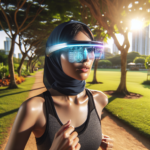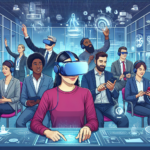Revolutionizing Product Design with Immersive Technologies and Virtual Prototyping 🎨
Understanding Immersive Technologies
Imagine stepping into a world where your product ideas leap off the page and come to life in 3D. This is the world of immersive technologies. By merging digital environments with physical reality, immersive technologies such as Virtual Reality (VR), Augmented Reality (AR), and Mixed Reality (MR) are transforming how we approach product design. These innovative tools provide designers and engineers with the ability to visualize, test, and iterate on their concepts like never before.
The Rise of Virtual Prototyping
Gone are the days of lengthy and expensive prototyping processes. Thanks to virtual prototyping, designers can now create, modify, and refine digital models with ease. This shift not only accelerates the design cycle but also significantly reduces costs and material waste. Here’s how virtual prototyping changes the game:
- Speed: Quick iterations allow for rapid prototyping and feedback.
- Cost-effective: Reduces the need for physical materials and testing.
- Flexibility: Easily modify designs based on real-time feedback.
- Enhanced Collaboration: Teams can work together in virtual environments, irrespective of their physical locations.
Why Immersive Technologies Matter in Product Design
The integration of immersive technologies into product design is not merely a trend; it is a necessity in today’s fast-paced market. Below are some key benefits:
1. Enhanced Visualization 🎥
Immersive technologies help designers visualize products in a three-dimensional space. By simulating real-world scenarios, designers can understand how the product will be used, addressing potential issues before they arise. This foresight is invaluable in creating user-centered designs.
2. Real-Time Feedback and Validation
With virtual prototypes, stakeholders can interact with designs from the comfort of their office or home. It allows for immediate feedback and adjustments, boosting confidence that the final product will meet user needs. Engaging with these prototypes increases the likelihood that everyone is on the same page when moving forward.
3. User-Centric Design Process
Immersive technologies allow for user testing earlier in the design process. By gathering insights from actual users interacting with virtual prototypes, designers can iterate quickly based on genuine user experiences. This approach leads to products that are not only functional but also desirable.
Applications of Immersive Technologies in Various Industries
The impact of immersive technologies and virtual prototyping spans numerous industries. Some noteworthy applications include:
- Automotive: Car manufacturers use VR to design intricate interiors and exteriors, train workers, and simulate safety tests.
- Healthcare: Virtual prototyping aids in designing medical devices and simulating surgeries, enhancing both product quality and training processes.
- Consumer Electronics: From smartphones to smartwatches, companies visualize and test products through immersive environments to meet user expectations.
- Architecture and Construction: Architects can create life-like representations of their designs, allowing clients to walk through spaces before they are built.
Challenges and Solutions in Implementing Immersive Technologies
While the advantages of immersive technologies are clear, there are hurdles to overcome. Some challenges include:
1. High Initial Investment 💰
Implementing VR and AR technologies can require considerable investment. However, the long-term savings from reduced prototyping costs and improved product outcomes often outweigh the initial expense. Companies can start small, gradually investing in more advanced tools as they see the benefits.
2. Technical Expertise
Creating immersive experiences requires skilled professionals who understand both design and technology. Training existing staff or hiring specialized talent can bridge this gap, ensuring that companies maximize their investment in these technologies.
Future Trends in Immersive Technologies and Product Design
The future of product design will be shaped by continuous advancements in immersive technologies. Here are some trends to watch for:
- Increased AI Integration: Artificial Intelligence (AI) will personalize design experiences and automate repetitive tasks, freeing up designers for more creative work.
- Greater Accessibility: As hardware becomes more affordable, immersive technologies will become accessible to smaller companies, leveling the playing field.
- Cloud-Based Environments: Cloud technology will enable collaborative virtual designing, allowing teams to work together from anywhere in the world.
- Enhanced Augmented Reality Experiences: As AR continues to evolve, expect highly interactive experiences that merge the physical and digital worlds seamlessly.
Final Thoughts on Immersive Technologies and Product Design
Embracing immersive technologies and virtual prototyping is not just a smart move; it is a vital strategy for staying ahead in today’s competitive market. The ability to visualize, test, and adapt products in a virtual space facilitates a more efficient and effective design process, resulting in products that truly resonate with users. As technology continues to evolve, the future of product design promises to be more innovative, collaborative, and user-focused than ever before. ✨




0 Comments